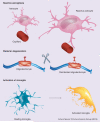Astroglia in neurological diseases
- PMID: 23658503
- PMCID: PMC3645493
- DOI: 10.2217/fnl.12.90
Astroglia in neurological diseases
Abstract
Astroglia encompass a subset of versatile glial cells that fulfill a major homeostatic role in the mammalian brain. Since any brain disease results from failure in brain homeostasis, astroglial cells are involved in many, if not all, aspects of neurological and/or psychiatric disorders. In this article, the roles of astrocytes as homeostatic cells in healthy and diseased brains are surveyed. These cells can mount the defence response to the insult of the brain, astrogliosis, when and where they display hypertrophy. Interestingly, astrocytes can alternatively display atrophy in some pathological conditions. Various pathologies, including Alexander and Alzheimer's diseases, amyotrophic lateral sclerosis, stroke and epilepsy, to mention a few, are discussed. Astrocytes could represent a novel target for medical intervention in the treatment of brain disorders.
Keywords: Alexander disease; Alzheimer's disease; amyotrophic lateral sclerosis; astroglia; astroglial atrophy; astrogliosis; ischemia; neurodegeneration; neuropathology; stroke.
Figures
Similar articles
-
PATHOBIOLOGY OF NEURODEGENERATION: THE ROLE FOR ASTROGLIA.Opera Med Physiol. 2016 Jan;1:13-22. Epub 2016 Mar 4. Opera Med Physiol. 2016. PMID: 27308639 Free PMC article.
-
General Pathophysiology of Astroglia.Adv Exp Med Biol. 2019;1175:149-179. doi: 10.1007/978-981-13-9913-8_7. Adv Exp Med Biol. 2019. PMID: 31583588 Free PMC article. Review.
-
Astrogliopathology in neurological, neurodevelopmental and psychiatric disorders.Neurobiol Dis. 2016 Jan;85:254-261. doi: 10.1016/j.nbd.2015.03.025. Epub 2015 Apr 3. Neurobiol Dis. 2016. PMID: 25843667 Free PMC article.
-
Astrocytes: a central element in neurological diseases.Acta Neuropathol. 2016 Mar;131(3):323-45. doi: 10.1007/s00401-015-1513-1. Epub 2015 Dec 15. Acta Neuropathol. 2016. PMID: 26671410 Review.
-
Astroglial atrophy in Alzheimer's disease.Pflugers Arch. 2019 Oct;471(10):1247-1261. doi: 10.1007/s00424-019-02310-2. Epub 2019 Sep 13. Pflugers Arch. 2019. PMID: 31520182 Review.
Cited by
-
Glia-Neurotrophic Factor Relationships: Possible Role in Pathobiology of Neuroinflammation-Related Brain Disorders.Int J Mol Sci. 2023 Mar 28;24(7):6321. doi: 10.3390/ijms24076321. Int J Mol Sci. 2023. PMID: 37047292 Free PMC article. Review.
-
Stratification of astrocytes in healthy and diseased brain.Brain Pathol. 2017 Sep;27(5):629-644. doi: 10.1111/bpa.12537. Brain Pathol. 2017. PMID: 28805002 Free PMC article.
-
Neuron-Astrocyte Interactions in Aging and Alzheimer's Disease: Dysregulation of Amyloid Precursor Protein.Ageing Longev. 2025 Feb;6(2):117-128. doi: 10.47855/jal9020-2025-2-3. Epub 2025 Feb 27. Ageing Longev. 2025. PMID: 40098995 Free PMC article.
-
Infection Augments Expression of Mechanosensing Piezo1 Channels in Amyloid Plaque-Reactive Astrocytes.Front Aging Neurosci. 2018 Oct 22;10:332. doi: 10.3389/fnagi.2018.00332. eCollection 2018. Front Aging Neurosci. 2018. PMID: 30405400 Free PMC article.
-
PATHOBIOLOGY OF NEURODEGENERATION: THE ROLE FOR ASTROGLIA.Opera Med Physiol. 2016 Jan;1:13-22. Epub 2016 Mar 4. Opera Med Physiol. 2016. PMID: 27308639 Free PMC article.
References
-
- Verkhratsky A. Physiology of neuronal–glial networking. Neurochem. Int. 2010;57(4):332–343. - PubMed
-
- Verkhratsky A, Butt A, editors. Physiology and Pathophysiology of Neuroglia. Wiley; Chichester, UK: 2013. [Provides an introduction to neuroglial function in health and disease.]
-
- Verkhratsky A, Parpura V, Rodriguez JJ. Where the thoughts dwell: the physiology of neuronal–glial ‘diffuse neural net’. Brain Res. Rev. 2011;66(1–2):133–151. - PubMed
-
- Kettenmann H, Ransom BR, editors. Neuroglia. 3rd Edition. Oxford University Press; Oxford, UK: 2012. [Most comprehensive reference book in the field.]
-
- Hanisch UK, Kettenmann H. Microglia: active sensor and versatile effector cells in the normal and pathologic brain. Nat. Neurosci. 2007;10(11):1387–1394. - PubMed
Grants and funding
LinkOut - more resources
Full Text Sources
Other Literature Sources


